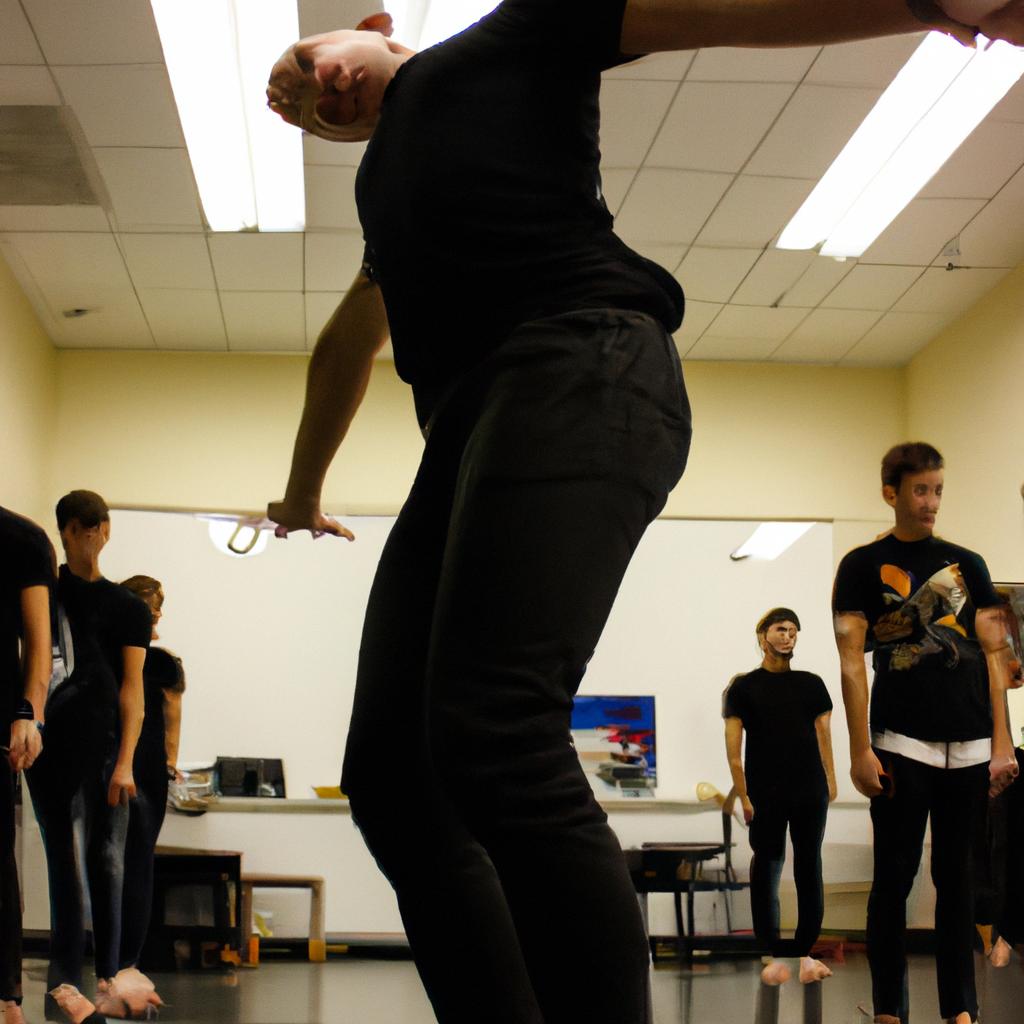Improv Theater: The Art of Spontaneity

Improv theater, also known as improvisational theater, is a captivating form of performance art that relies on the power of spontaneity. Its essence lies in creating unscripted scenes and narratives through collaboration among performers who make split-second decisions based on their instincts and creativity. This distinct genre has gained popularity not only for its entertaining qualities but also for its ability to enhance communication skills, boost confidence, and foster teamwork.
To illustrate this point, let us consider an example of a hypothetical scenario: imagine a group of individuals participating in an improv workshop. Initially hesitant and reserved, they gradually immerse themselves in exercises that encourage quick thinking and imaginative responses. As they embrace the principles of improvisation—such as accepting offers from fellow participants without hesitation or judgment—they begin to experience newfound freedom in expression and connection with others. Through the process of engaging in spontaneous storytelling within a supportive environment, these individuals discover hidden talents while developing essential life skills.
The following article delves into the world of improv theater, exploring its origins, techniques utilized by practitioners, benefits derived from its practice, and how it continues to captivate audiences around the globe. By examining both theoretical frameworks and practical applications of improvisation, this exploration aims to shed light on the transformative power that this art form possesses.
Throughout history, improv theater has been traced back to ancient civilizations, where storytelling and performance were integral parts of cultural practices. However, modern improvisational theater as we know it today emerged in the mid-20th century with influential figures like Viola Spolin and Keith Johnstone. They developed techniques and games that emphasized spontaneity, collaboration, and creativity.
One of the fundamental principles of improv is the concept of “Yes, And.” This principle encourages performers to accept whatever their fellow actors offer them onstage and build upon it. By embracing this mindset, participants learn to trust their instincts and let go of self-doubt or fear of failure. The result is a dynamic and engaging performance that unfolds organically.
Improvisation relies heavily on active listening and observation skills. Performers must pay close attention to their scene partners’ words, actions, and emotions in order to effectively respond in real time. This heightened level of attentiveness not only enhances communication skills but also fosters empathy and understanding among participants.
In addition to communication skills, improv theater cultivates quick thinking and adaptability. Since there is no script to follow, performers must rely on their ability to think on their feet and make split-second decisions. This agility translates into everyday life situations where being able to adapt to unexpected circumstances is crucial.
Furthermore, participating in improv workshops or performances can have a profound impact on an individual’s self-confidence. As performers gain experience navigating unscripted scenarios successfully, they become more comfortable taking risks and expressing themselves authentically. This newfound confidence often extends beyond the stage into various aspects of personal and professional life.
Teamwork is another essential element of improvisational theater. In scenes that require multiple performers, collaboration becomes key as individuals work together seamlessly without prior planning or rehearsal. Through shared experiences in creating something out of nothing, participants develop a sense of camaraderie and trust within the group.
The benefits of improv theater extend beyond individual growth and can be seen in audience engagement as well. Watching an improvised performance is a unique experience, as spectators witness the creation of a story unfold in real time. This element of surprise and unpredictability adds an extra layer of excitement and entertainment to the theatrical experience.
In conclusion, the transformative power of improv theater lies in its ability to foster creativity, enhance communication skills, boost confidence, and promote teamwork. Whether on stage or off, the principles and techniques of improvisation have proven to be valuable tools for personal growth and development. As this captivating form of performance art continues to captivate audiences around the world, its impact on individuals and communities remains profound.
What is Improv Theater?
Improv Theater, also known as improvisational theater or improv comedy, is a form of live performance that involves spontaneous creation and unscripted scenes. Unlike traditional theater where actors follow a predetermined script, in improv theater, performers rely on their wit, creativity, and teamwork to develop characters, dialogue, and plotlines in real-time.
To better understand the concept of improv theater, consider this hypothetical scenario: A group of actors steps onto an empty stage with no preconceived ideas or lines. They might ask the audience for suggestions such as a location or occupation to set the scene. From there, they create characters and initiate dialogue without any prior planning or rehearsal. The success of an improvised performance depends on the ability of the performers to respond swiftly to each other’s cues while maintaining coherence and humor.
Benefits of Improv Theater
Engaging in improv theater offers numerous benefits beyond just entertainment value. Here are some emotional responses often associated with it:
- Joy: Witnessing impromptu performances can bring joy by evoking genuine laughter and amusement.
- Surprise: Unexpected twists and turns keep audiences engaged and excited throughout an improv show.
- Empathy: Watching actors navigate unpredictable situations fosters empathy as we empathize with their emotions and reactions.
- Inspiration: By witnessing spontaneous creation onstage, viewers may be inspired to embrace spontaneity in their own lives.
Let us now delve into the history behind this fascinating art form which has gained popularity worldwide since its inception.
[Table will be inserted here]
As we explore the roots of improv theater, we gain insight into how it has evolved over time. So let’s journey back through history to discover how this unique style of performance came into existence.
The History of Improv Theater
Transition from previous section:
Having explored the concept of Improv Theater and its significance, we now turn our attention to its historical development. Understanding the origins of this art form can provide valuable insights into its evolution over time.
The History of Improv Theater
To comprehend the rich tapestry of Improv Theater, it is essential to explore its historical roots. One example that sheds light on the early beginnings of improvisational performance dates back to ancient Greek theater. During festivals like “City Dionysia,” actors would engage in spontaneous ad-libbing while performing tragedies or comedies. This offered them an opportunity to showcase their wit and creativity, captivating audiences with impromptu lines and interactions.
Over centuries, various forms of improvisation emerged across different cultures. In medieval Europe, traveling performers known as troubadours entertained crowds by spontaneously composing songs and stories based on audience suggestions. Similarly, Japanese Noh theater incorporated elements of improvisation during certain scenes, allowing actors to adapt their performances according to live reactions.
As we delve deeper into the history of improv theater, several key milestones stand out:
- The birth of Commedia dell’Arte in Italy during the 16th century.
- The emergence of Keith Johnstone’s “Theatresports” in Canada during the 1970s.
- The establishment of Chicago’s renowned Second City improv troupe in 1959.
- The popularization of long-form improvisation through shows like “Whose Line Is It Anyway?” in the late 20th century.
These developments marked significant turning points for improvised theater worldwide, shaping its contemporary landscape and influencing future generations of performers.
| Key Milestones | Location/Time Period |
|---|---|
| Commedia dell’Arte | Italy (16th Century) |
| Theatresports | Canada (1970s) |
| Second City | Chicago (1959) |
| “Whose Line Is It Anyway?” | Late 20th Century |
Understanding the historical context of improv theater provides a foundation for appreciating its enduring appeal and widespread practice. In upcoming sections, we will delve into the key elements that define this art form and explore how they contribute to its unique spontaneity and creativity.
Transition:
With an understanding of the historical development of improv theater, it is now time to examine its key elements and their role in creating captivating performances.
Key Elements of Improv Theater
Having explored the origins and development of improv theater, we now turn our attention to its key elements. Understanding these foundational components is crucial in appreciating how spontaneity takes center stage in this unique art form.
Improv theater relies on several fundamental elements that contribute to its dynamic and unpredictable nature. These elements combine harmoniously to create a captivating experience for both performers and audience members alike. Let us delve into some of the essential components:
-
Collaboration: At the heart of improv theater lies collaboration among performers. They work together as an ensemble, building scenes spontaneously through shared ideas and interactions. This collaborative aspect fosters trust and encourages actors to respond genuinely to their fellow castmates’ contributions.
-
Yes, And…: A core principle in improvisation is the concept of “Yes, And…” This technique involves accepting whatever idea or premise is presented by another performer (“yes”) and then adding something new or advancing the scene (“and”). By embracing this approach, participants avoid blocking each other’s ideas, allowing scenes to flow seamlessly with inventive twists and turns.
-
Spontaneity: As highlighted briefly in our discussion on history, one of the defining features of improv theater is its reliance on spontaneous creation without pre-planned scripts or rehearsed dialogue. Actors must think quickly on their feet, relying on instinct and creativity to develop characters, narratives, and comedic moments in real-time.
-
Risk-Taking: Inherent within improvisational performances is an element of risk-taking. Since scenes are developed in the moment without predetermined outcomes, there is always a chance for unexpected challenges or failures. Embracing these risks becomes part of the thrill for both performers and audiences, as it heightens anticipation and generates genuine reactions.
To emphasize further how these key elements intertwine within improv theater, consider the following hypothetical scenario: Two performers step onto the stage. They collaborate seamlessly, building a scene set in an old bookstore. Through “Yes, And…” they establish that the protagonist is searching for a lost book with mysterious powers. The spontaneity of their interactions leads to unexpected twists, such as encountering mythical creatures and unraveling hidden clues. In this enthralling display of risk-taking and creativity, both actors and spectators become fully immersed in the shared experience.
Understanding these key elements provides a solid foundation for appreciating the transformative benefits that improv theater offers. Let us now explore how participation in this art form can positively impact individuals personally, socially, and professionally.
Benefits of Improv Theater
Transitioning from the exploration of improv theater’s key elements, we now delve into understanding the benefits it offers. To illustrate its impact, consider a hypothetical scenario where an individual named Sarah joins an improv theater workshop to improve her communication skills and boost her confidence in social situations.
Engaging in improv theater can bring about numerous advantages for participants:
- Enhanced Communication Skills: Through improvisation exercises, individuals develop better listening and speaking abilities. They learn to actively listen, respond spontaneously, and effectively convey their ideas. This improved communication carries over into everyday interactions, leading to more meaningful connections with others.
- Increased Confidence: Participating in improv allows individuals to step out of their comfort zones and embrace uncertainty. By practicing spontaneous responses in a supportive environment, they gain self-assurance and become comfortable taking risks both on stage and off.
- Strengthened Collaboration: Improv heavily relies on teamwork and collaboration. Participants learn how to trust one another, adapt quickly to changing circumstances, and build upon each other’s ideas. These valuable skills extend beyond the realm of theater into professional settings.
The following table provides a visual representation of some key benefits offered by improv theater:
| Benefits of Improv Theater |
|---|
| Improved communication skills |
| Boosted confidence |
| Strengthened collaboration |
In summary, engaging in improv theater offers various advantages such as enhanced communication skills, increased confidence levels, and strengthened collaborative abilities. Through active participation in this art form, individuals like Sarah can experience personal growth that extends far beyond the boundaries of the stage.
Transitioning seamlessly into our next section on “Improvisation Techniques,” let us explore further methods through which improvisational skills are honed.
Improvisation Techniques
Transitioning from the previous section on the benefits of improv theater, let us delve into how improvisation techniques can foster personal growth and development. To illustrate this point, imagine a hypothetical scenario where an individual with social anxiety joins an improv theater group. Through regular participation in improvisational exercises and performances, they gradually build confidence in their ability to think on their feet and interact spontaneously.
Improvisation teaches individuals valuable skills that extend beyond the stage. Here are some ways in which improv theater positively impacts personal development:
-
Enhanced Communication Skills:
- Active listening: Participants learn to listen attentively to their scene partners, enabling them to respond effectively.
- Nonverbal cues: Improvisers become adept at reading body language and facial expressions, facilitating better understanding during interactions.
- Verbal agility: Quick thinking and articulate responses honed through improv help individuals express themselves clearly in various settings.
-
Increased Creativity:
- Thinking outside the box: By embracing uncertainty and exploring new ideas without fear of failure, participants develop creative problem-solving abilities.
- Spontaneity: Engaging in unscripted scenes allows for imaginative thinking and encourages individuals to trust their instincts.
- Risk-taking: The supportive environment of improv fosters a willingness to take risks creatively, leading to innovative approaches both on- and offstage.
-
Strengthened Emotional Intelligence:
- Empathy: Actors often need to understand others’ perspectives while performing improvised scenes, cultivating empathy towards different characters or situations.
- Emotional expression: By embodying diverse roles with authenticity, improvisers gain insight into emotions they may not typically experience personally.
- Adaptability: Navigating unpredictable scenarios onstage helps individuals adapt emotionally to unexpected real-life circumstances.
These transformative effects are further exemplified by renowned improv theater groups such as The Second City, Upright Citizens Brigade (UCB), IO Theater, and Groundlings. These groups have not only entertained audiences worldwide but also served as training grounds for countless performers who went on to achieve success in comedy, acting, and other creative fields.
Transitioning into the subsequent section about famous improv theater groups, we see how these influential institutions continue to shape the world of improvisation through their innovative approaches and talented alumni.
Famous Improv Theater Groups
Section H2: Improvisation Techniques
Improvisation techniques form the foundation of improv theater, allowing actors to create spontaneous performances on stage. These techniques are essential for performers to effectively engage with their fellow cast members and captivate audiences. By embracing these techniques, improvisers can navigate unpredictable scenarios and develop compelling narratives in real-time.
One example of an improvisation technique is “Yes, And.” This technique requires actors to accept whatever is presented by their scene partner and build upon it. For instance, imagine a hypothetical scenario where two characters are discussing plans for a surprise party. If one actor suggests having the party at a beach, the other actor would respond with enthusiasm—saying something like “Yes! And we could have a bonfire too!” This creates an open and collaborative atmosphere that fosters creativity and keeps scenes moving forward.
To further understand the importance of improvisation techniques, consider the following bullet points:
- Spontaneity: Improv theater encourages performers to think quickly on their feet, making split-second decisions without pre-planned scripts.
- Active Listening: Actors must actively listen to their scene partners’ offers and cues in order to respond appropriately and keep the scene flowing smoothly.
- Supportive Environment: An essential aspect of improv is creating a supportive environment where all ideas are accepted and celebrated.
- Risk-Taking: The nature of improv demands that actors take risks on stage, stepping outside their comfort zones to explore new possibilities.
In addition to understanding key concepts through bullet points, it can be helpful to analyze them using a table format:
| Technique | Description |
|---|---|
| Yes, And | Accepting your scene partner’s offer and building upon it |
| Active Listening | Paying close attention to your scene partner’s words and actions |
| Collaboration | Working together as a team towards a common goal |
By employing these improvisation techniques, actors can create engaging performances that captivate audiences. The ability to think on one’s feet, actively listen, and support fellow performers fosters an environment where creativity thrives. Through collaborative efforts and a willingness to take risks, the art of spontaneity is brought to life on stage.
(Note: The next section will be titled ‘Famous Improv Theater Groups’)






